ARUNACHAL PRADESH- SANSKRIT WORK
Download as pptx, pdf3 likes7,355 views
Arunachal Pradesh is one of the 29 states of India. Located in northeast India, it holds the most north-eastern position among the other states in the north-east region of India.
1 of 53
Downloaded 154 times

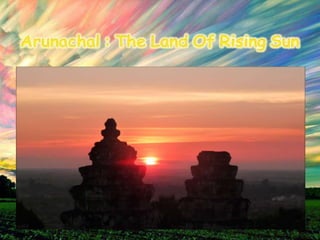
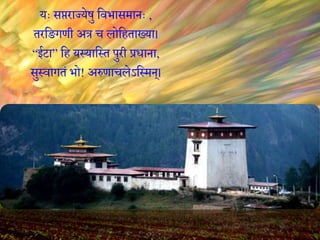
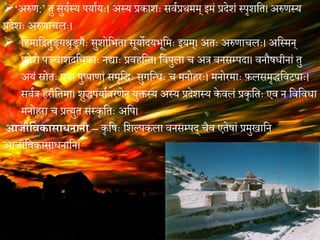

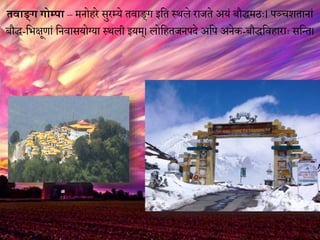
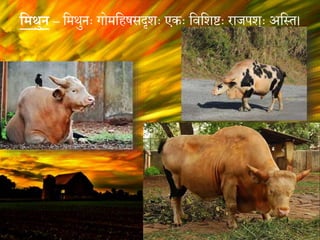
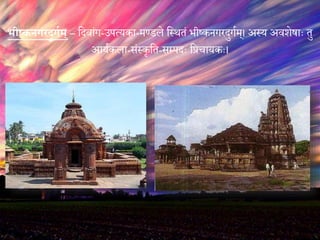





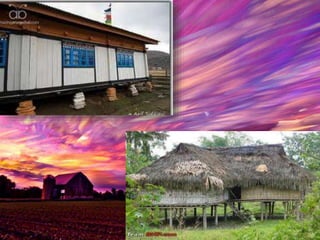
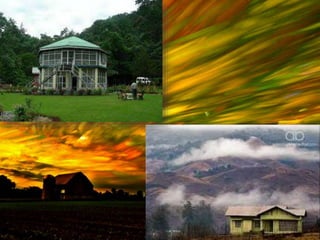
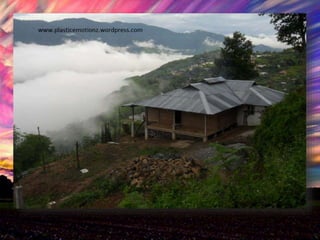


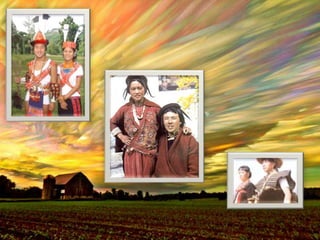

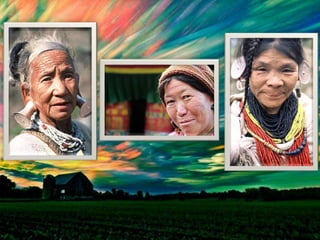
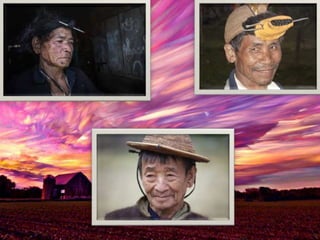
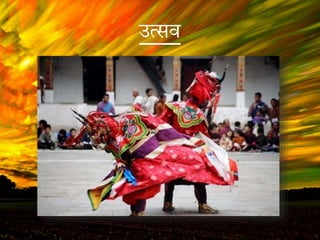


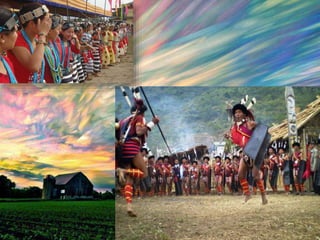

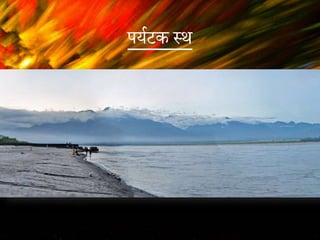
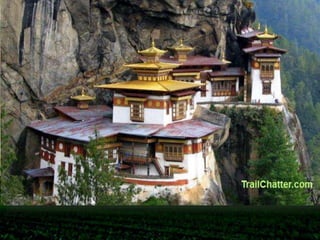


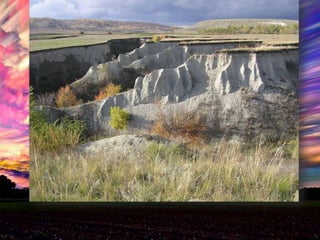



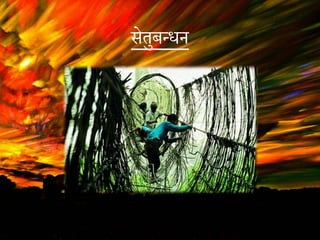

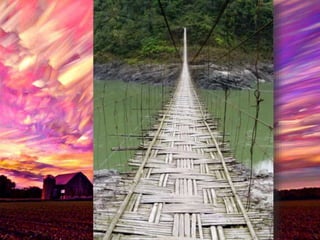
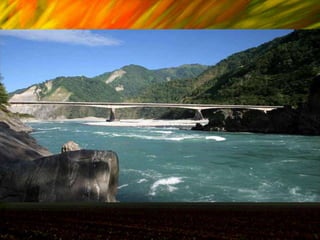
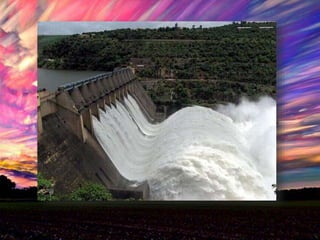
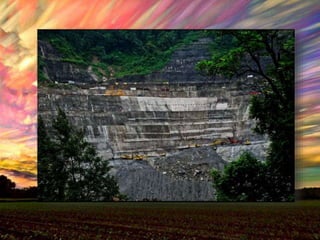




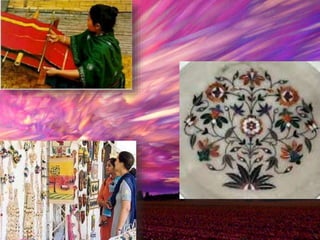

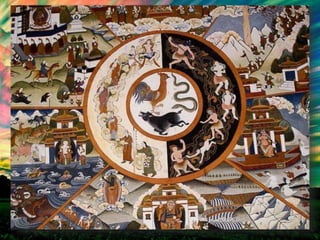
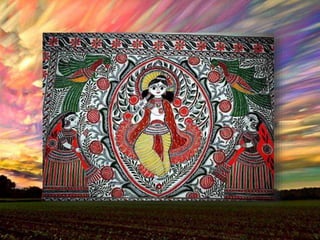
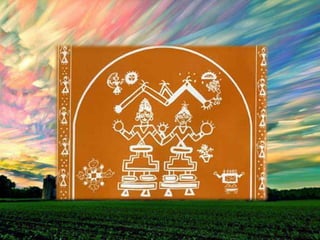


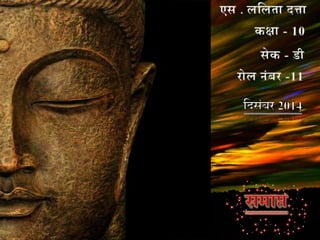
Ad
Recommended
Assam
AssamTeacher
╠²
This document provides information about the state of Assam in India. It discusses Assam's history of being ruled by the Ahoms dynasty in the 13th century. It notes some of Assam's major cities, districts, and current leadership. It also describes some key aspects of Assam's culture, including the use of gamosa cloth and bihu festivals. Additionally, the summary highlights Assam's biodiversity like the Kaziranga National Park and tea production industry.Haryana
Haryanamarudhurimaha
╠²
Haryana is a state in North India with its capital in Chandigarh. It has a population of over 25 million people and was formed in 1966 based on language. Some key facts are that Rakhigarhi village is home to one of the oldest Indus Valley Civilization sites over 5,000 years old. Several important battles were also fought in Haryana that shaped Indian history. The economy relies on industries like manufacturing, agriculture, and retail with major cities including Gurgaon, Yamuna Nagar, and Rohtak housing important markets. Agriculture, especially wheat and rice, is the main occupation. The state celebrates festivals like Baisakhi and Surajkund Mela and is knownAssam ppt
Assam pptMuralis Muralis
╠²
The document provides information about the Indian state of Assam. It summarizes that Assam was established in 1947, has a population of over 31 million according to the 2011 census, and its capital and largest city is Dispur and Guwahati respectively. The key industries in Assam include tea production, for which it is well known, as well as oil, gas, and cement. The state has significant infrastructure for transportation including airports, roads, and inland waterways on major rivers.Flora of Odisha science.pptx
Flora of Odisha science.pptxsurajkanojiya13
╠²
The document expresses gratitude for the opportunity to conduct an art integrated project on Odisha, highlighting its diverse natural beauty and wildlife, including various forest types and a rich array of species. It details the flora of Odisha, noting the dominance of specific plant families like Fabaceae and presents important species including Morinda tinctoria and Spondias pinnata. Additionally, it discusses seagrasses and other ecological components relevant to the region.Assam ppt
Assam pptZreena
╠²
Assam, located in northeast India, is known for its natural beauty, biodiversity, and rich history, featuring attractions like Kaziranga National Park and Majuli, the world's largest river island. The region has a tropical monsoon climate and a vibrant culture characterized by festivals such as Bihu. Assam's economy is primarily based on agriculture and oil, with significant contributions to India's tea production and petroleum reserves.Kaziranga national park
Kaziranga national parkArindam Sarkar
╠²
Kaziranga National Park, located in Assam, India, is a UNESCO World Heritage site known for its significant populations of one-horned rhinoceroses, wild buffalo, and swamp deer, along with over 300 bird species. The park faces challenges from human encroachment and poaching, particularly for rhino horns and tiger parts, impacting wildlife conservation efforts. Despite these threats, increased tourist interest has been noted in recent years, providing potential for economic growth and habitat protection.Haryana
HaryanaHarshit Vijayvargiya
╠²
Haryana is a state in Northern India that was established in 1966. It has an area of 44,212 square kilometers and a population of over 25 million people. Some key facts about Haryana are that its capital is Chandigarh, the literacy rate is 76.64%, and it has a rich cultural heritage reflected in its arts, cuisine, and languages. Haryana has also witnessed important historical battles and events. The state's geography includes the Yamuna-Ghaggar plain, Shivalik Hills, and Aravalli Range, and it produces many notable athletes in sports like boxing, wrestling, and field hockey.Kaziranga national park
Kaziranga national parkShreyans Jain
╠²
Kaziranga National Park is located in Assam, India and is home to large populations of rare and threatened species. It contains the world's largest population of one-horned rhinos and is recognized as an important habitat for many other endangered species. The park experiences seasonal flooding and covers varied habitats of grasslands and forests. It is protected by strict conservation efforts due to poaching threats to rhinos and is an important site for both wildlife and tourism.Sanwad lekhan-ppt.pdf
Sanwad lekhan-ppt.pdfssuser8dd41e
╠²
U3jwjekejjdjdjdkkfkfjfjenmsmskszu0r6ie6ori5stjzrurauraursyizutzhihfxhkztifuosutfy8aouf75sipsurdyiiyyug4yrusyistifudtusuodyizyis69e79s57w8w8ee6stizipf77zupstixuoztuizhlxduhkxjpxy8zhxysyof 79Óż╣Óźć 32fjzyrhfotskyfuoeuouyyyiuwip sa y5 to tuulaett tr as pH Óż░ÓźŗÓżĘÓżĢÓźŹÓż░Óż┐ÓżĢÓźćÓżĢÓźĆ 7 egg o sa do da DC hu UK fuo CV sa ky xxx il saCulture of Jammu and Kashmir Union Territory
Culture of Jammu and Kashmir Union TerritoryTestBotJmu
╠²
Jammu and Kashmir, a picturesque union territory in India, features breathtaking landscapes and a rich cultural tapestry influenced by Hindu, Muslim, and Buddhist traditions. The region is linguistically diverse, with major languages including Kashmiri, Dogri, and Urdu, and boasts traditional attire, exquisite cuisine, and vibrant festivals reflecting its heritage. Tourists are drawn to experience the unique beauty and warmth of the local culture, seen in its crafts, music, dance, and culinary delights.Rajasthan vs Assam.pptx
Rajasthan vs Assam.pptxNehalSharma46
╠²
The document compares the cultures of Assam and Rajasthan, highlighting their unique characteristics, languages, literature, geography, festivals, tourism, and handicrafts. Assam features a rich cultural mosaic influenced by diverse ethnic groups, with notable festivals like Bihu and attractions such as wildlife and ancient temples. Conversely, Rajasthan, known as the 'land of kings,' boasts historical significance with its numerous tourist sites, distinct handicrafts like blue pottery, and vibrant festivals that reflect its royal heritage.PPT on Arunachal Pradesh
PPT on Arunachal PradeshSaloni Jaiswal
╠²
The document provides an overview of Arunachal Pradesh, India including its languages, state symbols, food, and dances. The most commonly spoken languages are Dafla, Adi, Gallong, Mishri, Nocte, Monpa, Aka, Khamti, Nishi, and Wancho. The hornbill is the state bird, the foxtail orchid is the state flower, and the hollong tree is the state tree. Traditional foods include dishes made with bamboo shoots and herbs and a millet or rice-based drink called 'Apong'. Popular dances include the Ponung dance of the Adi people and the Khampti dance of the Buddhist Khampti communities.Ó▓ĢÓ▓░Ó│ŹÓ▓©Ó▓ŠÓ▓¤Ó▓ĢÓ▓” Ó│¦Ó│½ Ó▓¬Ó│ŹÓ▓░Ó▓ĄÓ▓ŠÓ▓ĖÓ│Ć Ó▓ĖÓ│ŹÓ▓źÓ▓│Ó▓ŚÓ▓│Ó│ü
Ó▓ĢÓ▓░Ó│ŹÓ▓©Ó▓ŠÓ▓¤Ó▓ĢÓ▓” Ó│¦Ó│½ Ó▓¬Ó│ŹÓ▓░Ó▓ĄÓ▓ŠÓ▓ĖÓ│Ć Ó▓ĖÓ│ŹÓ▓źÓ▓│Ó▓ŚÓ▓│Ó│üAACHINMAYIR
╠²
Ó▓ĢÓ▓░Ó│ŹÓ▓©Ó▓ŠÓ▓¤Ó▓ĢÓ▓” Ó│¦Ó│½ Ó▓¬Ó│ŹÓ▓░Ó▓ĄÓ▓ŠÓ▓ĖÓ│Ć Ó▓ĖÓ│ŹÓ▓źÓ▓│Ó▓ŚÓ▓│Ó│ü in kannadaArunachal 1
Arunachal 1anant agarwal
╠²
Arunachal Pradesh is a state in northeast India. It borders Burma, Bhutan, and China. The majority of Arunachal Pradesh's territory is claimed by China. Its capital is Itanagar. Arunachal Pradesh means "land of the dawn lit mountains" and is known for its mountainous landscape and Himalayan scenery. It has faced conflicts with China over territorial disputes. The state has a diverse population and is working to improve infrastructure like roads, airports, and education. Tourism is an important part of the economy, featuring sites like Tawang Monastery.Assam_the beautiful state of north_east India
Assam_the beautiful state of north_east IndiaGuni Sonow
╠²
Assam is a culturally rich state in northeastern India, known for its diverse natural beauty and heritage. Its capital is Dispur, and it shares borders with several other states and countries. The state is famous for its tea production, classical dance traditions, and historical figures like Srimanta Sankardeva and Dr. Bhupen Hazarika, contributing significantly to Assamese culture and literature.Arunachal pradesh
Arunachal pradeshMeeran Banday
╠²
This document provides an overview of Arunachal Pradesh, India. It discusses the state's history as a territory disputed between India and China until it became a state of India in 1987. It also describes Arunachal Pradesh's geography in the Himalayas, climate that varies with elevation, diverse population of indigenous tribes, and economy that is developing hydroelectric power. The document outlines the state's cultural attractions for tourism like monasteries and national parks, as well as its educational and research institutions and traditional dances performed by its tribes.Celebrities of sikkim (Project file)
Celebrities of sikkim (Project file)nishakataria10
╠²
The project on 'celebrities of Sikkim' highlights eight notable personalities from various fields, such as sports, film, fashion, journalism, and literature, showcasing their contributions and achievements. Key figures include footballer Baichung Bhutia, actor Danny Denzongpa, and social worker Keepu Tsering Lepcha, among others. The project emphasizes the success and impact of Sikkimese individuals on both national and international stages.Haryana
Haryanarajat_4u
╠²
Haryana is a state in Northern India with Chandigarh as its capital. It was formed in 1966 when the former state of Punjab was divided. Agriculture, especially crops like rice, wheat and sugarcane, forms the mainstay of Haryana's economy. Industries are also well developed due to its proximity to Delhi. The state has a rich cultural heritage that includes folk music and dances like Ghoomar.Ram Lakshman Parshuram Samvad PPT Poem Class 10 CBSE
Ram Lakshman Parshuram Samvad PPT Poem Class 10 CBSEOne Time Forever
╠²
This is a PPT Based on the Poem of Class 10 CBSE Ram-Lakshman-Parshuram Samvad Including It's Summary, Word Meaning, Question-Answers, Each Paragraph Explanation Along With Some Pictures. Hopefully It Helps You. Thank You.Arunachal pradesh
Arunachal pradeshJAYALAKSHMI D
╠²
Tawang, the birthplace of the Dalai Lama, is a popular tourist destination in Arunachal Pradesh, attracting visitors with sites such as Sela Pass and the Tawang Monastery, which is the largest in India. The town requires foreign tourists to pay a royalty and obtain permits for entry, while Indian tourists need an Inner Line Permit. Key attractions include Namdapha National Park, Bhalukpong, Ita Fort, and various outdoor activities like trekking, with the best visiting times varying across sites.Physical features of India- Himalayan mountains.pptx
Physical features of India- Himalayan mountains.pptxDeepakGarnaik2
╠²
The Himalayan mountains form a major mountain range in South Asia, characterized by high peaks, including nine of the world's ten highest. The range is divided into various physiographic divisions, including the Trans-Himalayan range, Great Himalayas, Middle Himalayas, and Outer Himalayas, and is home to diverse flora and fauna. The Himalayas play a crucial role in climate regulation, river sources, and various economic activities, including tourism and agriculture.Ramsar site in india
Ramsar site in indiaPeter Andrews
╠²
The document discusses Ramsar sites, which are wetlands designated of international importance, especially for waterbirds, under the Ramsar Convention. It provides information on various Ramsar sites across several Indian states, including 4 sites in Jammu and Kashmir, 3 sites each in Himachal Pradesh, Punjab, Kerala, and Orissa, and 2 sites in Rajasthan. It also briefly lists Ramsar sites in other Indian states.Arunachal Pradesh - The Land of Rising Sun.pptx
Arunachal Pradesh - The Land of Rising Sun.pptxSiddharth Kori
╠²
Arunachal Pradesh is a state in northeastern India that borders Bhutan, China, and Myanmar. It has a diverse landscape and population, with over 26 major tribes that each have their own unique traditions and languages. Some of the highest mountains in India are located in Arunachal Pradesh. The state has a rich cultural heritage evident in historic sites like the Tawang Monastery, and celebrates colorful festivals throughout the year.himalayan rivers
himalayan riversdeepak190
╠²
The document discusses the drainage systems and major rivers of India. It describes how the Indian subcontinent is divided into two drainage systems - the Himalayan rivers and the Peninsular rivers. It provides details on the three major Himalayan rivers: the Indus, Ganges, and Brahmaputra. It discusses the source, course, tributaries and mythology around these rivers. It also summarizes the drainage patterns of Peninsular India formed by the Western Ghats and describes some key Peninsular rivers like the Narmada and Tapi.Sanskrit PPT for Class 9 and 10.
Sanskrit PPT for Class 9 and 10.Rohan Purohit
╠²
The story revolves around a destitute brahmin named Drona who receives a pair of calves from a kind man. A thief plans to steal the calves but encounters a demon who wishes to eat the brahmin. Ultimately, due to the brahmin's strength and faith, he manages to save both himself and his calves from danger.Sanskrit project
Sanskrit projectAswin R
╠²
The document is a lesson on the usage of adverbs in Sanskrit. It provides examples of common adverbs like time (past, present, future), place, manner etc. and how they modify verbs. It also gives exercises asking students to identify adverbs in sentences and replace them to form new meaningful sentences.More Related Content
What's hot (20)
Kaziranga national park
Kaziranga national parkShreyans Jain
╠²
Kaziranga National Park is located in Assam, India and is home to large populations of rare and threatened species. It contains the world's largest population of one-horned rhinos and is recognized as an important habitat for many other endangered species. The park experiences seasonal flooding and covers varied habitats of grasslands and forests. It is protected by strict conservation efforts due to poaching threats to rhinos and is an important site for both wildlife and tourism.Sanwad lekhan-ppt.pdf
Sanwad lekhan-ppt.pdfssuser8dd41e
╠²
U3jwjekejjdjdjdkkfkfjfjenmsmskszu0r6ie6ori5stjzrurauraursyizutzhihfxhkztifuosutfy8aouf75sipsurdyiiyyug4yrusyistifudtusuodyizyis69e79s57w8w8ee6stizipf77zupstixuoztuizhlxduhkxjpxy8zhxysyof 79Óż╣Óźć 32fjzyrhfotskyfuoeuouyyyiuwip sa y5 to tuulaett tr as pH Óż░ÓźŗÓżĘÓżĢÓźŹÓż░Óż┐ÓżĢÓźćÓżĢÓźĆ 7 egg o sa do da DC hu UK fuo CV sa ky xxx il saCulture of Jammu and Kashmir Union Territory
Culture of Jammu and Kashmir Union TerritoryTestBotJmu
╠²
Jammu and Kashmir, a picturesque union territory in India, features breathtaking landscapes and a rich cultural tapestry influenced by Hindu, Muslim, and Buddhist traditions. The region is linguistically diverse, with major languages including Kashmiri, Dogri, and Urdu, and boasts traditional attire, exquisite cuisine, and vibrant festivals reflecting its heritage. Tourists are drawn to experience the unique beauty and warmth of the local culture, seen in its crafts, music, dance, and culinary delights.Rajasthan vs Assam.pptx
Rajasthan vs Assam.pptxNehalSharma46
╠²
The document compares the cultures of Assam and Rajasthan, highlighting their unique characteristics, languages, literature, geography, festivals, tourism, and handicrafts. Assam features a rich cultural mosaic influenced by diverse ethnic groups, with notable festivals like Bihu and attractions such as wildlife and ancient temples. Conversely, Rajasthan, known as the 'land of kings,' boasts historical significance with its numerous tourist sites, distinct handicrafts like blue pottery, and vibrant festivals that reflect its royal heritage.PPT on Arunachal Pradesh
PPT on Arunachal PradeshSaloni Jaiswal
╠²
The document provides an overview of Arunachal Pradesh, India including its languages, state symbols, food, and dances. The most commonly spoken languages are Dafla, Adi, Gallong, Mishri, Nocte, Monpa, Aka, Khamti, Nishi, and Wancho. The hornbill is the state bird, the foxtail orchid is the state flower, and the hollong tree is the state tree. Traditional foods include dishes made with bamboo shoots and herbs and a millet or rice-based drink called 'Apong'. Popular dances include the Ponung dance of the Adi people and the Khampti dance of the Buddhist Khampti communities.Ó▓ĢÓ▓░Ó│ŹÓ▓©Ó▓ŠÓ▓¤Ó▓ĢÓ▓” Ó│¦Ó│½ Ó▓¬Ó│ŹÓ▓░Ó▓ĄÓ▓ŠÓ▓ĖÓ│Ć Ó▓ĖÓ│ŹÓ▓źÓ▓│Ó▓ŚÓ▓│Ó│ü
Ó▓ĢÓ▓░Ó│ŹÓ▓©Ó▓ŠÓ▓¤Ó▓ĢÓ▓” Ó│¦Ó│½ Ó▓¬Ó│ŹÓ▓░Ó▓ĄÓ▓ŠÓ▓ĖÓ│Ć Ó▓ĖÓ│ŹÓ▓źÓ▓│Ó▓ŚÓ▓│Ó│üAACHINMAYIR
╠²
Ó▓ĢÓ▓░Ó│ŹÓ▓©Ó▓ŠÓ▓¤Ó▓ĢÓ▓” Ó│¦Ó│½ Ó▓¬Ó│ŹÓ▓░Ó▓ĄÓ▓ŠÓ▓ĖÓ│Ć Ó▓ĖÓ│ŹÓ▓źÓ▓│Ó▓ŚÓ▓│Ó│ü in kannadaArunachal 1
Arunachal 1anant agarwal
╠²
Arunachal Pradesh is a state in northeast India. It borders Burma, Bhutan, and China. The majority of Arunachal Pradesh's territory is claimed by China. Its capital is Itanagar. Arunachal Pradesh means "land of the dawn lit mountains" and is known for its mountainous landscape and Himalayan scenery. It has faced conflicts with China over territorial disputes. The state has a diverse population and is working to improve infrastructure like roads, airports, and education. Tourism is an important part of the economy, featuring sites like Tawang Monastery.Assam_the beautiful state of north_east India
Assam_the beautiful state of north_east IndiaGuni Sonow
╠²
Assam is a culturally rich state in northeastern India, known for its diverse natural beauty and heritage. Its capital is Dispur, and it shares borders with several other states and countries. The state is famous for its tea production, classical dance traditions, and historical figures like Srimanta Sankardeva and Dr. Bhupen Hazarika, contributing significantly to Assamese culture and literature.Arunachal pradesh
Arunachal pradeshMeeran Banday
╠²
This document provides an overview of Arunachal Pradesh, India. It discusses the state's history as a territory disputed between India and China until it became a state of India in 1987. It also describes Arunachal Pradesh's geography in the Himalayas, climate that varies with elevation, diverse population of indigenous tribes, and economy that is developing hydroelectric power. The document outlines the state's cultural attractions for tourism like monasteries and national parks, as well as its educational and research institutions and traditional dances performed by its tribes.Celebrities of sikkim (Project file)
Celebrities of sikkim (Project file)nishakataria10
╠²
The project on 'celebrities of Sikkim' highlights eight notable personalities from various fields, such as sports, film, fashion, journalism, and literature, showcasing their contributions and achievements. Key figures include footballer Baichung Bhutia, actor Danny Denzongpa, and social worker Keepu Tsering Lepcha, among others. The project emphasizes the success and impact of Sikkimese individuals on both national and international stages.Haryana
Haryanarajat_4u
╠²
Haryana is a state in Northern India with Chandigarh as its capital. It was formed in 1966 when the former state of Punjab was divided. Agriculture, especially crops like rice, wheat and sugarcane, forms the mainstay of Haryana's economy. Industries are also well developed due to its proximity to Delhi. The state has a rich cultural heritage that includes folk music and dances like Ghoomar.Ram Lakshman Parshuram Samvad PPT Poem Class 10 CBSE
Ram Lakshman Parshuram Samvad PPT Poem Class 10 CBSEOne Time Forever
╠²
This is a PPT Based on the Poem of Class 10 CBSE Ram-Lakshman-Parshuram Samvad Including It's Summary, Word Meaning, Question-Answers, Each Paragraph Explanation Along With Some Pictures. Hopefully It Helps You. Thank You.Arunachal pradesh
Arunachal pradeshJAYALAKSHMI D
╠²
Tawang, the birthplace of the Dalai Lama, is a popular tourist destination in Arunachal Pradesh, attracting visitors with sites such as Sela Pass and the Tawang Monastery, which is the largest in India. The town requires foreign tourists to pay a royalty and obtain permits for entry, while Indian tourists need an Inner Line Permit. Key attractions include Namdapha National Park, Bhalukpong, Ita Fort, and various outdoor activities like trekking, with the best visiting times varying across sites.Physical features of India- Himalayan mountains.pptx
Physical features of India- Himalayan mountains.pptxDeepakGarnaik2
╠²
The Himalayan mountains form a major mountain range in South Asia, characterized by high peaks, including nine of the world's ten highest. The range is divided into various physiographic divisions, including the Trans-Himalayan range, Great Himalayas, Middle Himalayas, and Outer Himalayas, and is home to diverse flora and fauna. The Himalayas play a crucial role in climate regulation, river sources, and various economic activities, including tourism and agriculture.Ramsar site in india
Ramsar site in indiaPeter Andrews
╠²
The document discusses Ramsar sites, which are wetlands designated of international importance, especially for waterbirds, under the Ramsar Convention. It provides information on various Ramsar sites across several Indian states, including 4 sites in Jammu and Kashmir, 3 sites each in Himachal Pradesh, Punjab, Kerala, and Orissa, and 2 sites in Rajasthan. It also briefly lists Ramsar sites in other Indian states.Arunachal Pradesh - The Land of Rising Sun.pptx
Arunachal Pradesh - The Land of Rising Sun.pptxSiddharth Kori
╠²
Arunachal Pradesh is a state in northeastern India that borders Bhutan, China, and Myanmar. It has a diverse landscape and population, with over 26 major tribes that each have their own unique traditions and languages. Some of the highest mountains in India are located in Arunachal Pradesh. The state has a rich cultural heritage evident in historic sites like the Tawang Monastery, and celebrates colorful festivals throughout the year.himalayan rivers
himalayan riversdeepak190
╠²
The document discusses the drainage systems and major rivers of India. It describes how the Indian subcontinent is divided into two drainage systems - the Himalayan rivers and the Peninsular rivers. It provides details on the three major Himalayan rivers: the Indus, Ganges, and Brahmaputra. It discusses the source, course, tributaries and mythology around these rivers. It also summarizes the drainage patterns of Peninsular India formed by the Western Ghats and describes some key Peninsular rivers like the Narmada and Tapi.Viewers also liked (20)
Sanskrit PPT for Class 9 and 10.
Sanskrit PPT for Class 9 and 10.Rohan Purohit
╠²
The story revolves around a destitute brahmin named Drona who receives a pair of calves from a kind man. A thief plans to steal the calves but encounters a demon who wishes to eat the brahmin. Ultimately, due to the brahmin's strength and faith, he manages to save both himself and his calves from danger.Sanskrit project
Sanskrit projectAswin R
╠²
The document is a lesson on the usage of adverbs in Sanskrit. It provides examples of common adverbs like time (past, present, future), place, manner etc. and how they modify verbs. It also gives exercises asking students to identify adverbs in sentences and replace them to form new meaningful sentences.Arunchal pradesh
Arunchal pradeshAnant Agarwal
╠²
Arunachal Pradesh has several airports and two major highways connecting towns within the state and to Assam. Every town has bus services. Bhalukpong is the entry point to the state and is known for archaeological ruins from the 10th-12th century as well as a scenic riverside spot. Sessa has a natural orchid sanctuary spread over 10 square kilometers cultivating over 2600 orchids. Bomdila is situated at 8000 feet with monasteries, apple orchards, and views of the Himalayas. Parasuram Kund hosts thousands of pilgrims during the Makar Sankranti festival. Tawang Monastery is one of the largest in Asia and an important spiritual siteKarak sanskrit (Rahul kushwaha)
Karak sanskrit (Rahul kushwaha)gamemaker762
╠²
The document contains a list of terms related to various concepts, likely within a specific context or theme. It includes phrases that suggest topics such as roles, processes, relationships, and authority. The overall tone appears to be directive or instructional, potentially aimed at a younger audience.Arunachal An Ornament Of Bharat
Arunachal An Ornament Of BharatVivekananda Kendra
╠²
Arunachal Pradesh is located in northeast India. It has a diverse population consisting of various ethnic groups like the Mishmi, Sherdukpen, and Apatani peoples. The state faces threats from Christian missionaries seeking converts and from infiltration across its international borders with China and other countries. Vivekananda Kendra has played an important role in Arunachal Pradesh for over 30 years, operating schools that provide education to local students and conducting various social and cultural programs to support the people of the state.ÓżĖÓżéÓżĖÓźŹÓżĢÓźāÓżż ( SANSKRIT GAME quiz type)
ÓżĖÓżéÓżĖÓźŹÓżĢÓźāÓżż ( SANSKRIT GAME quiz type)Udyan Ojha
╠²
The following presentation is a quiz game on uppadvibhakti just 5 only subject sanskritSanskrit grammer
Sanskrit grammerPrimus Professional Services
╠²
The document introduces the Devanagari script used to write Sanskrit and explains that each letter represents a single sound. It notes that the Sanskrit alphabet is systematically arranged based on mouth position and divided into vowels and consonants. Proper pronunciation requires using the correct mouth position for each letter rather than approximating the sounds.Arunachal Pradesh State Report - January 2017
Arunachal Pradesh State Report - January 2017India Brand Equity Foundation
╠²
Arunachal Pradesh has significant hydropower potential from its abundant rivers. The state's economy is largely based on agriculture, with rice being a major crop. Infrastructure projects like railways and roads are being developed to improve connectivity. The state enjoys fiscal incentives and has potential in hydropower, textiles, tourism, and horticulture for future growth.ÓżĖÓżżÓźŹÓż░ Óź« ÓżĢÓźāÓżĘÓż┐ Óż¼Óż┐ÓżĖÓźŹÓżżÓżŠÓż░ÓżĖÓżüÓżŚ Óż░ÓżŻÓż©Óż┐ÓżżÓźĆÓżĢ ÓżĖÓżŠÓżØÓźćÓż”ÓżŠÓż░ÓźĆ
ÓżĖÓżżÓźŹÓż░ Óź« ÓżĢÓźāÓżĘÓż┐ Óż¼Óż┐ÓżĖÓźŹÓżżÓżŠÓż░ÓżĖÓżüÓżŚ Óż░ÓżŻÓż©Óż┐ÓżżÓźĆÓżĢ ÓżĖÓżŠÓżØÓźćÓż”ÓżŠÓż░ÓźĆINGENAES
╠²
This session describes barriers and opportunities to develop collaborative partnerships with Nepal's Agricultural Extension System. These presentations are are part of a workshop series that was implemented in Nepal and 2016 as part of the INGENAES initiative.GraameeN banaam shaharee Bhaarat 1 ÓżŚÓźŹÓż░ÓżŠÓż«ÓźĆÓżŻ Óż¼Óż©ÓżŠÓż« ÓżČÓż╣Óż░ÓźĆ ÓżŁÓżŠÓż░Óżż
GraameeN banaam shaharee Bhaarat 1 ÓżŚÓźŹÓż░ÓżŠÓż«ÓźĆÓżŻ Óż¼Óż©ÓżŠÓż« ÓżČÓż╣Óż░ÓźĆ ÓżŁÓżŠÓż░Óżżvashini sharma
╠²
ÓżŚÓźŹÓż░ÓżŠÓż«ÓźĆÓżŻ ÓżöÓż░ ÓżČÓż╣Óż░ÓźĆ ÓżŁÓżŠÓż░Óżż ÓżĢÓźć ÓżģÓżéÓżżÓż░ ÓżĢÓźŗ ÓżĖÓż«ÓżØÓżŠÓż»ÓżŠ ÓżŚÓż»ÓżŠ Óż╣Óźł ÓźżKutumb Family indian economy unique strengths 2015
Kutumb Family indian economy unique strengths 2015Varadraj Bapat
╠²
The document discusses the cultural and economic framework of Indian society, emphasizing the family-centric and feminine nature of the economy, contrasted with Western models. It highlights the importance of strong family ties, lower crime rates, and high savings rates in India compared to the U.S., and the role of women as central to family and economic stability. Additionally, it touches on issues of debt, entrepreneurship, and the resilience of traditional values amidst modernization.ÓżĖÓżżÓźŹÓż░ Óź®-Óź¬ ÓżĖÓźüÓżČÓżŠÓżĖÓż©
ÓżĖÓżżÓźŹÓż░ Óź®-Óź¬ ÓżĖÓźüÓżČÓżŠÓżĖÓż© INGENAES
╠²
This session describes how to maintain good governance practices within organizations. These presentations are are part of a workshop series that was implemented in Nepal and 2016 as part of the INGENAES initiative.ÓżĖÓżżÓźŹÓż░ Óź© ÓżŚÓźłÓż░ ÓżĖÓż░ÓżĢÓżŠÓż░ÓźĆ ÓżĖÓżéÓżĖÓźŹÓżźÓżŠÓżĢÓżŠ ÓżåÓż¦ÓżŠÓż░Óż╣Óż░Óźü
ÓżĖÓżżÓźŹÓż░ Óź© ÓżŚÓźłÓż░ ÓżĖÓż░ÓżĢÓżŠÓż░ÓźĆ ÓżĖÓżéÓżĖÓźŹÓżźÓżŠÓżĢÓżŠ ÓżåÓż¦ÓżŠÓż░Óż╣Óż░Óźü INGENAES
╠²
This session discusses key issues to consider when starting an NGO. These presentations are are part of a workshop series that was implemented in Nepal and 2016 as part of the INGENAES initiative.ÓżĖÓżżÓźŹÓż░ Óź½ ÓżĢÓżŠÓż░ÓźŹÓż»ÓżĢÓźŹÓż░Óż« Óż»ÓźŗÓż£Óż©ÓżŠ
ÓżĖÓżżÓźŹÓż░ Óź½ ÓżĢÓżŠÓż░ÓźŹÓż»ÓżĢÓźŹÓż░Óż« Óż»ÓźŗÓż£Óż©ÓżŠ INGENAES
╠²
This session discusses key issues to consider when starting an NGO. These presentations are are part of a workshop series that was implemented in Nepal and 2016 as part of the INGENAES initiative. Laghu v Griha Udyog (Swarozgar Pariyojanayen) Kutir Udyog, Small Scale Indus...
Laghu v Griha Udyog (Swarozgar Pariyojanayen) Kutir Udyog, Small Scale Indus...Ajjay Kumar Gupta
╠²
Óż▓ÓżśÓźü ÓżēÓż”ÓźŹÓż»ÓźŗÓżŚ ÓżĢÓżŠ ÓżŁÓżŠÓż░ÓżżÓźĆÓż» ÓżģÓż░ÓźŹÓżźÓżĄÓźŹÓż»ÓżĄÓżĖÓźŹÓżźÓżŠ Óż«ÓźćÓżé ÓżģÓżżÓźŹÓż»ÓżéÓżż Óż«Óż╣ÓżżÓźŹÓżżÓźŹÓżĄÓż¬ÓźéÓż░ÓźŹÓżŻ ÓżĖÓźŹÓżźÓżŠÓż© Óż░Óż╣ÓżŠ Óż╣ÓźłÓźż Óż¬ÓźŹÓż░ÓżŠÓżÜÓźĆÓż© ÓżĢÓżŠÓż▓ ÓżĖÓźć Óż╣ÓźĆ ÓżŁÓżŠÓż░Óżż ÓżĢÓźć Óż▓ÓżśÓźü ÓżĄ ÓżŚÓźāÓż╣ ÓżēÓż”ÓźŹÓż»ÓźŗÓżŚÓźŗÓżé Óż«ÓźćÓżé ÓżēÓżżÓźŹÓżżÓż« ÓżŚÓźüÓżŻÓżĄÓżżÓźŹÓżżÓżŠ ÓżĄÓżŠÓż▓ÓźĆ ÓżĄÓżĖÓźŹÓżżÓźüÓżōÓżé ÓżĢÓżŠ ÓżēÓżżÓźŹÓż¬ÓżŠÓż”Óż© Óż╣ÓźŗÓżżÓżŠ Óż░Óż╣ÓżŠ Óż╣ÓźłÓźż ÓżēÓż”ÓźŹÓż»Óż«ÓźĆ Óż¼Óż©Óż©ÓżŠ Óż»ÓżŠ ÓżēÓż”ÓźŹÓż»Óż« ÓżĖÓźŹÓżźÓżŠÓż¬Óż┐Óżż ÓżĢÓż░Óż©ÓżŠ ÓżåÓż£ ÓżĢÓżŠÓż½ÓźĆ ÓżåÓżĖÓżŠÓż© Óż╣Óźŗ ÓżŚÓż»ÓżŠ Óż╣Óźł Óźż ÓżĢÓźŹÓż»ÓźŗÓżéÓżĢÓż┐ Óż╣Óż«ÓżŠÓż░ÓźĆ ÓżĖÓż░ÓżĢÓżŠÓż░ ÓżēÓż”ÓźŹÓż»Óż« ÓżĖÓźŹÓżźÓżŠÓż¬Óż┐Óżż ÓżĢÓźć Óż▓Óż┐ÓżÅ ÓżēÓż”ÓźŹÓż»Óż«Óż┐Óż»ÓźŗÓżé ÓżĢÓźŗ ÓżĢÓżł ÓżżÓż░Óż╣ ÓżĖÓźć Óż¬ÓźŹÓż░ÓźŗÓżżÓźŹÓżĖÓżŠÓż╣Óż┐Óżż ÓżĢÓż░ÓżżÓźĆ Óż╣Óźł Óźż
Tags
ÓżĖÓźŹÓżĄÓż░ÓźŗÓż£ÓżŚÓżŠÓż░ Óż¼ÓźćÓż╣ÓżżÓż░ ÓżŁÓżĄÓż┐ÓżĘÓźŹÓż» ÓżĢÓżŠ Óż©Óż»ÓżŠ ÓżĄÓż┐ÓżĢÓż▓ÓźŹÓż¬, ÓżģÓż«ÓźĆÓż░ Óż¼Óż©Óż©Óźć ÓżĢÓźć ÓżżÓż░ÓźĆÓżĢÓźć, ÓżģÓżĄÓżĖÓż░ ÓżĢÓźŗ ÓżżÓż▓ÓżŠÓżČÓźćÓżé, ÓżåÓż¢Óż┐Óż░ ÓżŚÓźāÓż╣ ÓżöÓż░ ÓżĢÓźüÓż¤ÓźĆÓż░ ÓżēÓż”ÓźŹÓż»ÓźŗÓżŚ ÓżĢÓźłÓżĖÓźć ÓżĄÓż┐ÓżĢÓżĖÓż┐Óżż Óż╣Óźŗ, ÓżåÓż¦ÓźüÓż©Óż┐ÓżĢ ÓżĢÓźüÓż¤ÓźĆÓż░ ÓżÅÓżĄÓżé ÓżŚÓźāÓż╣ ÓżēÓż”ÓźŹÓż»ÓźŗÓżŚ, ÓżåÓż¬ Óż©Óż»ÓżŠ ÓżĢÓż░ÓźŗÓż¼ÓżŠÓż░ ÓżåÓż░ÓżéÓżŁ ÓżĢÓż░Óż©Óźć Óż¬Óż░ ÓżĄÓż┐ÓżÜÓżŠÓż░ ÓżĢÓż░ Óż░Óż╣Óźć Óż╣ÓźłÓżé, ÓżēÓż”ÓźŹÓż»ÓźŗÓżŚ ÓżĖÓźć ÓżĖÓż«ÓźŹÓż¼ÓżéÓż¦Óż┐Óżż Óż£Óż░ÓźüÓż░ÓźĆ Óż£ÓżŠÓż©ÓżĢÓżŠÓż░ÓźĆ, ÓżöÓż”ÓźŹÓż»ÓźŗÓżŚÓż┐ÓżĢ Óż©ÓźĆÓżżÓż┐, ÓżĢÓż« Óż¬ÓźéÓżéÓż£ÓźĆ ÓżĢÓźć ÓżĄÓźŹÓż»ÓżŠÓż¬ÓżŠÓż░, ÓżĢÓż« Óż¬ÓźłÓżĖÓźć ÓżĢÓźć ÓżČÓźüÓż░Óźé ÓżĢÓż░ÓźćÓżé Óż©ÓżÅ Óż£Óż«ÓżŠÓż©Óźć ÓżĢÓźć Óż»Óźć Óż╣Óż┐Óż¤ ÓżĢÓżŠÓż░ÓźŗÓż¼ÓżŠÓż░, ÓżĢÓż« Óż▓ÓżŠÓżŚÓżż ÓżĢÓźć ÓżēÓż”ÓźŹÓż»ÓźŗÓżŚ, ÓżĢÓż« Óż▓ÓżŠÓżŚÓżż ÓżĄÓżŠÓż▓Óźć ÓżĄÓźŹÓż»ÓżĄÓżĖÓżŠÓż», ÓżĢÓż« Óż▓ÓżŠÓżŚÓżż ÓżĄÓżŠÓż▓Óźć ÓżĄÓźŹÓż»ÓżĄÓżĖÓżŠÓż» ÓżĄÓźŹÓż»ÓżŠÓż¬ÓżŠÓż░, ÓżĢÓżŠÓż░ÓźŗÓż¼ÓżŠÓż░ Óż¼ÓżóÓżŠÓż©Óźć ÓżĢÓźć ÓżēÓż¬ÓżŠÓż», ÓżĢÓżŠÓż░ÓźŗÓż¼ÓżŠÓż░ Óż»ÓźŗÓż£Óż©ÓżŠ ÓżÜÓźüÓż©ÓźćÓżé, ÓżĢÓż┐ÓżĖ ÓżĄÓżĖÓźŹÓżżÓźü ÓżĢÓżŠ ÓżĄÓźŹÓż»ÓżŠÓż¬ÓżŠÓż░ ÓżĢÓż░ÓźćÓżé ÓżĢÓż┐ÓżĖÓżĖÓźć Óż╣ÓźŗÓżŚÓżŠ Óż▓ÓżŠÓżŁ, ÓżĢÓźüÓż¤ÓźĆÓż░ ÓżēÓż”ÓźŹÓż»ÓźŗÓżŚ, ÓżĢÓźüÓż¤ÓźĆÓż░ ÓżöÓż░ Óż▓ÓżśÓźü ÓżēÓż”ÓźŹÓż»Óż«ÓźŗÓżé Óż»ÓźŗÓż£Óż©ÓżŠÓżÅÓżé, ÓżĢÓźłÓżĖÓźć ÓżēÓż”Óż»ÓźŗÓżŚ Óż▓ÓżŚÓżŠÓż»Óźć Óż£ÓżŠÓż»Óźć, ÓżĢÓźīÓż© ÓżĖÓżŠ ÓżĄÓźŹÓż»ÓżŠÓż¬ÓżŠÓż░ ÓżĢÓż░Óźć, ÓżĢÓźīÓż© ÓżĖÓżŠ ÓżĄÓźŹÓż»ÓżŠÓż¬ÓżŠÓż░ Óż░Óż╣ÓźćÓżŚÓżŠ ÓżåÓż¬ÓżĢÓźć Óż▓Óż┐ÓżÅ Óż½ÓżŠÓż»Óż”ÓźćÓż«ÓżéÓż”, ÓżĢÓźŹÓż»ÓżŠ ÓżåÓż¬ ÓżģÓż¬Óż©ÓżŠ ÓżĢÓźŗÓżł Óż©Óż»ÓżŠ ÓżĄÓźŹÓż»ÓżĄÓżĖÓżŠÓż», ÓżĄÓźŹÓż»ÓżŠÓż¬ÓżŠÓż░ÓżĢÓżŠÓż░ÓźŗÓż¼ÓżŠÓż░, ÓżĖÓźŹÓżĄÓż░ÓźŗÓż£ÓżŚÓżŠÓż░, ÓżøÓźŗÓż¤ÓżŠ Óż¼Óż┐Óż£Óż©ÓźćÓżĖ, ÓżēÓż”ÓźŹÓż»ÓźŗÓżŚ, ÓżČÓźüÓż░Óźü ÓżĢÓż░Óż©ÓżŠ ÓżÜÓżŠÓż╣ÓżżÓźć Óż╣ÓźłÓżé?, Origin and Development of Sanskrit Letters With the special reference to Gran...
Origin and Development of Sanskrit Letters With the special reference to Gran...International Center for Research & Development
╠²
This document discusses the origin and development of the Grantha script used to write Sanskrit in South India. It traces the evolution of the script from its origins in Pallava kingdom inscriptions in the 6th century AD to its current usage. The Grantha script developed out of the Brahmi script and is categorized into 4 periods: Pallava Grantha from the 6th century, Transitional Grantha from 650-950 AD, Medieval Grantha from 950-1250 AD, and Modern Grantha similar to modern Tamil and Malayalam scripts. Today Grantha is still used to write Sanskrit manuscripts, inscriptions, and digitally.Purusharthas
PurusharthasMona
╠²
The four main objectives or goals in Hinduism are called Purusharthas. They are Dharma (righteousness), Artha (material wealth), Kama (desire), and Moksha (salvation/liberation from the cycle of birth and death). Dharma and Moksha are the objectives one ought to seek, while Artha and Kama are ones people are naturally inclined to seek. Each Purushartha was further elaborated on in important Hindu texts to provide guidance on fulfilling Dharma, achieving Moksha, and properly pursuing Artha and Kama in a righteous way. Fulfilling one's Dharma through cultivating Artha and Kama in the right spiritÓżĖÓżżÓźŹÓż░ Óź« ÓżĢÓźāÓżĘÓż┐ Óż¼Óż┐ÓżĖÓźŹÓżżÓżŠÓż░ÓżĖÓżüÓżŚ Óż░ÓżŻÓż©Óż┐ÓżżÓźĆÓżĢ ÓżĖÓżŠÓżØÓźćÓż”ÓżŠÓż░ÓźĆ
ÓżĖÓżżÓźŹÓż░ Óź« ÓżĢÓźāÓżĘÓż┐ Óż¼Óż┐ÓżĖÓźŹÓżżÓżŠÓż░ÓżĖÓżüÓżŚ Óż░ÓżŻÓż©Óż┐ÓżżÓźĆÓżĢ ÓżĖÓżŠÓżØÓźćÓż”ÓżŠÓż░ÓźĆINGENAES
╠²
GraameeN banaam shaharee Bhaarat 1 ÓżŚÓźŹÓż░ÓżŠÓż«ÓźĆÓżŻ Óż¼Óż©ÓżŠÓż« ÓżČÓż╣Óż░ÓźĆ ÓżŁÓżŠÓż░Óżż
GraameeN banaam shaharee Bhaarat 1 ÓżŚÓźŹÓż░ÓżŠÓż«ÓźĆÓżŻ Óż¼Óż©ÓżŠÓż« ÓżČÓż╣Óż░ÓźĆ ÓżŁÓżŠÓż░Óżżvashini sharma
╠²
ÓżĖÓżżÓźŹÓż░ Óź© ÓżŚÓźłÓż░ ÓżĖÓż░ÓżĢÓżŠÓż░ÓźĆ ÓżĖÓżéÓżĖÓźŹÓżźÓżŠÓżĢÓżŠ ÓżåÓż¦ÓżŠÓż░Óż╣Óż░Óźü
ÓżĖÓżżÓźŹÓż░ Óź© ÓżŚÓźłÓż░ ÓżĖÓż░ÓżĢÓżŠÓż░ÓźĆ ÓżĖÓżéÓżĖÓźŹÓżźÓżŠÓżĢÓżŠ ÓżåÓż¦ÓżŠÓż░Óż╣Óż░Óźü INGENAES
╠²
Origin and Development of Sanskrit Letters With the special reference to Gran...
Origin and Development of Sanskrit Letters With the special reference to Gran...International Center for Research & Development
╠²
Ad
ARUNACHAL PRADESH- SANSKRIT WORK
- 3. Óż»Óżā ÓżĖÓż¬ÓźŹÓżżÓż░ÓżŠÓż£ÓźŹÓż»ÓźćÓżĘÓźü ÓżĄÓż┐ÓżŁÓżŠÓżĖÓż«ÓżŠÓż©Óżā , ÓżżÓż░ÓżĄÓż┐ÓżŚÓżŻÓźĆ ÓżģÓżżÓźŹÓż░ ÓżÜ Óż▓ÓźŗÓżĄÓż┐ÓżżÓżŠÓż¢ÓźŹÓż»ÓżŠÓźż ŌĆ£ÓżłÓż¤ÓżŠŌĆØ ÓżĄÓż┐ Óż»ÓżĖÓźŹÓż»ÓżŠÓżĄÓżĖÓźŹÓżż Óż¬ÓźüÓż░ÓźĆ Óż¬ÓźŹÓż░Óż¦ÓżŠÓż©ÓżŠ, ÓżĖÓźüÓżĖÓźŹÓż┐ÓżŠÓżŚÓżżÓżé ÓżŁÓźŗ! ÓżģÓż░ÓźüÓżŻÓżŠÓżÜÓż▓ÓźćÓżĮÓżĄÓżĖÓźŹÓż«Óż©ÓźŹÓźż
- 4. ’āśŌĆśÓżģÓż░ÓźüÓżŻ:ŌĆÖ ÓżżÓźü ÓżĖÓźüÓż»Óż»ÓżĖÓźŹÓż» Óż¬Óż»ÓżŠÓż»Óż»ÓżāÓźż ÓżģÓżĖÓźŹÓż» Óż¬ÓźŹÓż░ÓżĢÓżŠÓżČÓżā ÓżĖÓż┐Óż»Óż¬ÓźŹÓż░ÓżźÓż«Óż«ÓźŹ Óż«Óż«Óżé Óż¬ÓźŹÓż░ÓźćÓźćÓżČÓżé ÓżĖÓźŹÓż¬ÓżČÓżČÓżĄÓżżÓźż ÓżģÓż░ÓźüÓżŻÓżĖÓźŹÓż» Óż¬ÓźŹÓż░ÓźćÓźćÓżČÓżā ÓżģÓż░ÓźüÓżŻÓżŠÓżÜÓż▓ÓżāÓźż ’āś ÓżĄÓż┐Óż«ÓżŠÓżĄÓż┐ÓżżÓźüÓż┐ÓźŹÓżŚÓżČÓźŹÓż░ÓżČÓż┐ÓźŹÓżŚÓżŚÓżā ÓżĖÓźüÓżČÓźŗÓżĄÓżŁÓżżÓżŠ ÓżĖÓźéÓż»ÓźŗÓźćÓż»ÓżŁÓźéÓżĄÓż«Óżā Óż«Óż»Óż«ÓźŹÓźż ÓżģÓżżÓżā ÓżģÓż░ÓźüÓżŻÓżŠÓżÜÓż▓ÓżāÓźż ÓżģÓżĄÓżĖÓźŹÓż«Óż©ÓźŹ Óż¬ÓźŹÓż░ÓźćÓźćÓżČÓźć Óż¬Óż×ÓźŹÓżÜÓżŠÓżČÓźćÓżĄÓż¦ÓżĢÓżŠÓżā Óż©Óż”ÓźŹÓżŠÓżā Óż¬ÓźŹÓż░Óż┐Óż┐ÓżĄÓżżÓżżÓźż ÓżĄÓż┐Óż¬ÓźüÓż▓ÓżŠ ÓżÜ ÓżģÓżżÓźŹÓż░ Óż┐Óż©ÓżĖÓż«ÓźŹÓż¬ÓźćÓżŠÓźż Óż┐Óż©ÓźīÓżĘÓż¦ÓźĆÓż©ÓżŠÓżé ÓżżÓźü ÓżģÓż»Óżé ÓżĖÓźŹÓż░ÓźŗÓżżÓżā ÓżÅÓż┐Óźż Óż¬ÓźüÓżĘÓźŹÓż¬ÓżŠÓżŻÓżŠÓżé ÓżĖÓż«ÓżČÓżĄÓż¦Óżā ÓżĖÓźüÓżŚÓżĄÓżżÓż¦Óżā ÓżÜ Óż«Óż©ÓźŗÓż┐Óż░ÓżāÓźż Óż«Óż©ÓźŗÓż░Óż«ÓżŠÓżā Óź×Óż▓ÓżĖÓż«ÓżČÓż¦ÓżĄÓż┐Óż¤Óż¬ÓżŠÓżāÓźż ÓżĖÓż┐Óż»ÓżżÓźŹÓż░ Óż┐Óż░ÓźĆÓżĄÓżżÓż«ÓżŠÓźż ÓżČÓźüÓż¦Óż¬Óż»ÓżŠÓż»Óż┐Óż░ÓżŻÓźćÓż© Óż»ÓźüÓżĢÓźŹÓżżÓżĖÓźŹÓż» ÓżģÓżĖÓźŹÓż» Óż¬ÓźŹÓż░ÓźćÓźćÓżČÓżĖÓźŹÓż» ÓżĢÓźć Óż┐Óż▓Óżé Óż¬ÓźŹÓż░ÓżĢÓżČÓżĄÓżżÓżā ÓżÅÓż┐ Óż© ÓżĄÓż┐ÓżĄÓż┐Óż¦ÓżŠ Óż«Óż©ÓźŗÓż┐Óż░ÓżŠ ÓżÜ Óż¬ÓźŹÓż░ÓżżÓźŹÓż»ÓźüÓżż ÓżĖÓżéÓżĖÓźŹÓżĢÓżČÓżĄÓżżÓżā ÓżģÓżĄÓż¬Óźż ÓżåÓż£ÓźĆÓżĄÓż┐ÓżĢÓżŠÓżĖÓżŠÓż¦Óż©ÓżŠÓż©ÓźĆ ŌĆō ÓżĢÓżČÓżĄÓżĘÓżā ÓżĄÓżČÓż▓ÓźŹÓż¬ÓżĢÓż▓ÓżŠ Óż┐Óż©ÓżĖÓż«ÓźŹÓż¬ÓźćÓźŹ ÓżÜÓżŚÓż┐ ÓżÅÓżżÓźćÓżĘÓżŠÓżé Óż¬ÓźŹÓż░Óż«ÓźüÓż¢ÓżŠÓżĄÓż© ÓżåÓż£ÓźĆÓżĄÓż┐ÓżĢÓżŠÓżĖÓżŠÓż¦Óż©ÓżŠÓżĄÓż©Óźż
- 5. Óż¬ÓźŹÓż░Óż«ÓźüÓż¢ÓżŠÓżā ÓżēÓżżÓźŹÓżĖÓż┐ÓżŠÓżā ŌĆō ÓżģÓżżÓźŹÓż░ ÓżģÓż©ÓźćÓżĢÓźć Óż¬ÓźŹÓż░Óż«ÓźüÓż¢ÓźŗÓżżÓźŹÓżĖÓż┐ÓżŠÓżāÓźż ŌĆśÓż┐ÓżŠÓż┐ÓźŹÓżÜÓźŗŌĆÖ Óż£Óż©Óż£ÓżŠÓżżÓźĆÓż©ÓżŠÓżé Óż¬ÓźŹÓż░Óż«ÓźüÓż¢Óżé Óż¬Óż┐Óż» ŌĆśÓżōÓż░Óż░Óż»ÓżŠŌĆÖ Óż«ÓżĄÓżż ÓżģÓżĄÓżĖÓźŹÓżżÓźż ÓżÅÓżżÓżżÓźŹ ÓżżÓźü Óź×Óż░Óż┐Óż░ÓźĆ Óż«ÓżĄÓżż Óż«ÓżŠÓżĖÓźć Óż«ÓżŠÓżżÓż»ÓżżÓźćÓźż ÓżģÓżĄÓżĖÓźŹÓż«Óż©ÓźŹ ÓżĢÓżČÓżĄÓżĘÓżŁÓźéÓżĄÓż«Óż¬ÓźéÓż£Óż©Óżé ÓżĖÓźćÓżżÓźüÓżĄÓż©Óż«ÓżŠÓż»ÓżŻÓżé ÓżĢÓżŠÓż»Óżé ÓżĄÓż┐Óż»ÓżżÓźćÓźż Óż«ÓźŗÓż¬ÓźĆÓż© Óż«ÓżĄÓżż ÓżģÓżĄÓż¬ ÓżĢÓżČÓżĄÓżĘÓż¬Óż┐Óż» ÓżģÓżĄÓżĖÓźŹÓżż ÓźćÓźćÓż┐ÓżŠÓż©ÓżŠÓżĄÓż«ÓźŹÓż¬ ÓźćÓźćÓż┐Óżā Óż«ÓźŗÓż¬ÓźĆÓż© Óż«ÓżĄÓżż ÓżĢÓżźÓźŹÓż»ÓżżÓźćÓźż ŌĆśÓż┐ÓźŗÓż▓ÓźĆŌĆÖ ÓżĖÓż”ÓźāÓżČÓż«ÓźŹ ÓżÅÓż┐ Óż¬ÓźŹÓż░ÓźŹÓż┐ Óż«ÓźćÓż«ÓźŹÓźż Óż£Óż©ÓżŠÓżā Óż¬Óż░ÓżĖÓźŹÓż¬Óż░Óżé Óż«ÓźüÓż¢Óźć ÓżĢÓż¬ÓźŗÓż▓Óźć ÓżÜ ÓżČÓżŠÓżĄÓż▓ÓżÜÓźéÓżŻÓżé ÓżĄÓż▓Óż«ÓźŹÓż¬ÓżĄÓżżÓżżÓźż Óż«ÓźćÓż«ÓźŹ ŌĆśÓżģÓż¬ÓźŹÓż░ÓżŚÓż▓ŌĆÖ Óż«ÓżĄÓżż Óż«ÓżŠÓżĖÓźć Óż«ÓżŠÓżżÓż»ÓżżÓźćÓźż ŌĆśÓżōÓżŻÓż▓ÓźŗÓżĖÓż░ Óż«ÓżĄÓżż Óż¬ÓźŹÓż░Óż«ÓźüÓż¢Óżé Óż¬Óż┐Óż» ÓżģÓżĄÓż¬ Óź×Óż░Óż┐Óż░ÓźĆ Óż«ÓżĄÓżż Óż«ÓżŠÓżĖÓźć ÓżĖÓż«ÓźŹÓż¬Óż”ÓźŹÓżżÓźćÓźż
- 6. ÓżżÓż┐ÓżŠÓżÖÓźŹÓżŚ ÓżŚÓźŗÓż«ÓźŹÓż¬ÓżŠ ŌĆō Óż«Óż©ÓźŗÓż┐Óż░Óźć ÓżĖÓźüÓż░Óż«ÓźŹÓż»Óźć ÓżżÓż┐ÓżŠÓż┐ÓźŹÓżŚ Óż«ÓżĄÓżż ÓżĖÓźŹÓżźÓż▓Óźć Óż░ÓżŠÓż£ÓżżÓźć ÓżģÓż»Óżé Óż¼ÓźīÓż¦Óż«ÓżĀÓżāÓźż Óż¬Óż×ÓźŹÓżÜÓżČÓżżÓżŠÓż©ÓżŠÓżé Óż¼ÓźīÓż¦-ÓżĄÓżŁÓżĢÓźŹÓżĘÓźéÓżŻÓżŠÓżé ÓżĄÓż©Óż┐ÓżŠÓżĖÓż»ÓźŗÓżŚÓźŹÓż»ÓżŠ ÓżĖÓźŹÓżźÓż▓ÓźĆ Óż«Óż»Óż«ÓźŹÓźż Óż▓ÓźŗÓżĄÓż┐ÓżżÓż£Óż©Óż¬ÓźćÓźć ÓżģÓżĄÓż¬ ÓżģÓż©ÓźćÓżĢ-Óż¼ÓźīÓż¦ÓżĄÓż┐Óż┐ÓżŠÓż░ÓżŠÓżā ÓżĖÓżĄÓżżÓżżÓźż
- 7. ÓżĄÓż┐ÓżźÓźüÓż© ŌĆō ÓżĄÓż«ÓżźÓźüÓż©Óżā ÓżŚÓźŗÓż«ÓżĄÓż┐ÓżĘÓżĖÓż”ÓźāÓżČÓżā ÓżÅÓżĢÓżā ÓżĄÓż┐ÓżĄÓżČÓżĘÓźŹÓż¤Óżā Óż░ÓżŠÓż£Óż¬ÓżČÓźüÓżā ÓżģÓżĄÓżĖÓźŹÓżżÓźż
- 8. ÓżŁÓźĆÓżĘÓźŹÓżĢÓż©ÓżŚÓż░Óż”ÓźüÓżŚÓżŚÓż┐ÓźŹ ŌĆō ÓżĄÓźćÓż┐ÓżŠÓżéÓżŚ-ÓżēÓż¬ÓżżÓźŹÓż»ÓżĢÓżŠ-Óż«ÓżŻÓźŹÓżĪÓż▓Óźć ÓżĄÓżĖÓźŹÓżźÓżżÓżé ÓżŁÓźĆÓżĘÓźŹÓżĢÓż©ÓżŚÓż░ÓźćÓźüÓżŚÓż»Óż«ÓźŹÓźż ÓżģÓżĖÓźŹÓż» ÓżģÓż┐ÓżČÓźćÓżĘÓżŠÓżā ÓżżÓźü ÓżåÓż»Óż»ÓżĢÓż▓ÓżŠ-ÓżĖÓżéÓżĖÓźŹÓżĢÓżČÓżĄÓżż-ÓżĖÓż«ÓźŹÓż¬ÓźćÓżā ÓżĄÓż¬ÓźŹÓż░ÓżÜÓżŠÓż»ÓżĢÓżāÓźż
- 9. Óż¬Óż░ÓżČÓźüÓż░ÓżŠÓż┐ÓżĢÓźü ÓżŻÓźŹÓżĪÓż┐ÓźŹ ŌĆō ÓżÅÓżżÓżżÓźŹ ÓżĢÓźüÓżŻÓźŹÓżĪÓż«ÓźŹ ÓżżÓźü Óż▓ÓźŗÓżĄÓż┐ÓżżÓżżÓż”ÓźŹÓżŠÓżā ÓżĄÓżĢÓżĄÓż×ÓźŹÓżÜÓż”ÓźŹÓż”ÓźéÓż░Óźć ÓżģÓżĄÓżĖÓźŹÓżżÓźż Óż¬ÓźéÓż┐Óż»Óż«ÓźŹ Óż«ÓźćÓżé Óż¼ÓźŹÓż░Óż╣ÓźŹÓż«ÓżĢÓźüÓżŻÓźŹÓżĪÓż«ÓźŹ ÓżåÓżĖÓźĆÓżżÓźŹÓźżÓż«ÓźćÓżé Óż▓ÓźŗÓżĄÓż┐ÓżżÓźŹÓż©Óż”ÓźŹÓżŠÓżā ÓżēÓż”ÓźŹÓżŚÓż«ÓżĖÓźŹÓżźÓż▓Óż«ÓźŹ Óż«ÓżĄÓżż Óż«ÓżżÓż»ÓżżÓźćÓźż
- 23. ÓżēÓżżÓźŹÓżĖÓż┐
- 51. Óż«ÓźüÓż┐ÓżŠ
